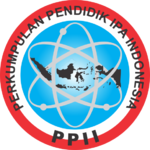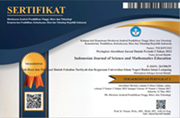Exploring students’ concept images of fractions: A hermeneutic phenomenology study
Abstract
Keywords
Full Text:
PDFReferences
A. Kullberg and U. Runesson, “Learning about the numerator and denominator in teacher-designed lessons,” Mathematics Education Research Journal, vol. 25, no. 4, pp. 547–567, Dec. 2013, doi: 10.1007/s13394-013-0080-9.
S. Getenet and R. Callingham, “Teaching interrelated concepts of fraction for understanding and teacher’s pedagogical content knowledge,” Mathematics Education Research Journal, vol. 33, no. 2, pp. 201–221, Jun. 2021, doi: 10.1007/s13394-019-00275-0.
A. Roni, Z. Zulkardi, and R. I. Indra Putri, “Learning divisions of fractions through sprint running pictures,” Journal of Education and Learning (EduLearn), vol. 11, no. 4, pp. 381–393, Nov. 2017, doi: 10.11591/edulearn.v11i4.5982.
E. Unaenah, D. Suryadi, and T. Turmudi, “Epistemological learning obstacles on fractions in elementary school,” Jurnal Elemen, vol. 10, no. 1, pp. 1–12, Feb. 2024, doi: 10.29408/jel.v10i1.18306.
J. Coetzee and K. J. Mammen, “Science and engineering students’ difficulties with fractions at entry-level to university,” International Electronic Journal of Mathematics Education, vol. 12, no. 3, pp. 281–310, Jun. 2017, doi: 10.29333/iejme/614.
R. F. M. Gagani and F. M. Diano JR, “Characterizing the difficulty in fraction operation,” International Journal of Advanced Research and Publications (IJARP), vol. 3, no. 6, pp. 168–174, 2019.
H. Lortie-Forgues, J. Tian, and R. S. Siegler, “Why is learning fraction and decimal arithmetic so difficult?,” Developmental Review, vol. 38, pp. 201–221, Dec. 2015, doi: 10.1016/j.dr.2015.07.008.
S. J. Lamon, Teaching fractions and ratios for understanding, 4th ed. New York: Routledge, 2020. doi: 10.4324/9781003008057.
M. Behr, G. Harel, T. Post, and R. Lesh, “Rational numbers: Toward a semantic analysis -emphasis on the operator construct,” in Rational numbers: An integration of research, T. P. Carpenter, E. Fennema, and T. A. Romberg, Eds., Hillsdale, NJ: Lawrence Erlbaum Associates, 1993, pp. 13–47.
M. A. Simon, N. Placa, A. Avitzur, and M. Kara, “Promoting a concept of fraction-as-measure: A study of the learning through activity research program,” The Journal of Mathematical Behavior, vol. 52, pp. 122–133, Dec. 2018, doi: 10.1016/j.jmathb.2018.03.004.
S. Prediger, “How to develop mathematics-for-teaching and for understanding: the case of meanings of the equal sign,” Journal of Mathematics Teacher Education, vol. 13, no. 1, pp. 73–93, Feb. 2010, doi: 10.1007/s10857-009-9119-y.
J. Sherman and J. Bisanz, “Equivalence in symbolic and nonsymbolic contexts: Benefits of solving problems with manipulatives.,” J Educ Psychol, vol. 101, no. 1, pp. 88–100, Feb. 2009, doi: 10.1037/a0013156.
L. Ardiansari, D. Suryadi, and D. Dasari, “The concept image of students and teachers about the equal sign,” Universal Journal of Educational Research, vol. 8, no. 12, pp. 6751–6764, Dec. 2020, doi: 10.13189/ujer.2020.081240.
E. Unaenah, D. Suryadi, and Turmudi, “Students’ learning obstacles on fractions in elementary school,” in Proceedings of the International Conference on Education 2022 (ICE 2022), A. P. Wibawa, R. Pristiani, G. Kurubacak, S. S. Mustakim, D. Kuswandi, and R. Herdianto, Eds., Atlantis Press, 2023, pp. 148–157. doi: 10.2991/978-2-38476-020-6_16.
M. G. Isnawan, D. Suryadi, and T. Turmudi, “Strategies to minimize students’ learning obstacle in fractions: A grounded theory,” Jurnal Pendidikan MIPA, vol. 23, no. 1, pp. 87–99, 2022, doi: 10.23960/jpmipa/v23i1.pp67-79.
M. G. Isnawan, D. Suryadi, and T. Turmudi, “How secondary students develop the meaning of fractions? A hermeneutic phenomenological study,” Beta: Jurnal Tadris Matematika, vol. 15, no. 1, pp. 1–19, Apr. 2022, doi: 10.20414/betajtm.v15i1.496.
M. Hariyani, T. Herman, D. Suryadi, and S. Prabawanto, “Exploration of student learning obstacles in solving fraction problems in elementary school,” Int J Educ Method, vol. 8, no. 3, pp. 505–515, Aug. 2022, doi: 10.12973/ijem.8.3.505.
I. Fauzi and D. Suryadi, “The analysis of students’ learning obstacles on the fraction addition material for five graders of elementary schools,” Al Ibtida: Jurnal Pendidikan Guru MI, vol. 7, no. 1, pp. 33–45, Jun. 2020, doi: 10.24235/al.ibtida.snj.v7i1.6020.
A. D. K. Pamarna, D. Juandi, and Al Jupri, “Missing concept image dan mis-in concept image pada materi segi empat ditinjau dari gaya kognitif,” Ideguru: Jurnal Karya Ilmiah Guru, vol. 9, no. 3, pp. 1788–1796, Jul. 2024, doi: 10.51169/ideguru.v9i3.1289.
D. Tall and S. Vinner, “Concept image and concept definition in mathematics with particular reference to limits and continuity,” Educational Studies in Mathematics, vol. 12, no. 2, pp. 151–169, May 1981, doi: 10.1007/BF00305619.
S. Vinner, “The role of definitions in the teaching and learning of mathematics,” in Advanced mathematical thinking, vol. 11, D. Tall, Ed., Dordrecht: Springer Netherlands, 2002, pp. 65–81. doi: 10.1007/0-306-47203-1_5.
P. Tsamir, D. Tirosh, E. Levenson, R. Barkai, and M. Tabach, “Early-years teachers’ concept images and concept definitions: triangles, circles, and cylinders,” ZDM, vol. 47, no. 3, pp. 497–509, Jun. 2015, doi: 10.1007/s11858-014-0641-8.
D. Serhan, “Students’ understanding of the definite integral concept,” International Journal of Research in Education and Science (IJRES), vol. 1, no. 1, pp. 184–188, 2015.
B. Vincent, R. LaRue, V. Sealey, and N. Engelke, “Calculus students’ early concept images of tangent lines,” Int J Math Educ Sci Technol, vol. 46, no. 5, pp. 641–657, Jul. 2015, doi: 10.1080/0020739X.2015.1005700.
M. D. Siagian, D. Suryadi, E. Nurlaelah, M. Tamur, and R. Sulastri, “Investigating students’ concept image in understanding variables,” J Phys Conf Ser, vol. 1882, no. 1, p. 012058, May 2021, doi: 10.1088/1742-6596/1882/1/012058.
D. Langdridge, Phenomenological psychology: Theory, research and method. Harlow, UK: Pearson Education, 2007.
C. Grbich, Qualitative data analysis: An introduction. London: SAGE Publications Ltd, 2013. doi: 10.4135/9781529799606.
D. Suryadi, Penelitian desain didaktis (DDR) dan implementasinya. Bandung: Gapura Press, 2019.
J. Bleicher, Contemporary hermeneutics: hermeneutics as method, philosophy, and critique, 1st ed. New York: Routledge, 1980. doi: 10.4324/9781315112558.
P. Ricœur, Lectures on ideology and utopia. New York: Columbia University Press, 1986.
P. Regan, “Hans-Georg Gadamer’s philosophical hermeneutics: Concepts of reading, understanding and interpretation,” Meta: Research in Hermeneutics, Phenomenology, and Practical Philosophy, vol. 4, no. 2, pp. 286–303, 2012.
J. Grandgirard, D. Poinsot, L. Krespi, J. Nénon, and A. Cortesero, “Costs of secondary parasitism in the facultative hyperparasitoid Pachycrepoideus dubius: does host size matter?,” Entomol Exp Appl, vol. 103, no. 3, pp. 239–248, Jun. 2002, doi: 10.1046/j.1570-7458.2002.00982.x.
A. Hendriyanto et al., “The didactic phenomenon: Deciphering students’ learning obstacles in set theory,” Journal on Mathematics Education, vol. 15, no. 2, pp. 517–544, 2024.
J. A. Van de Walle, K. S. Karp, and J. M. Bay-Williams, Elementary and middle school mathematics: teaching developmentally, 7th ed. Boston: Allyn & Bacon, 2010.
M. R. Clark, S. B. Berenson, and L. O. Cavey, “A comparison of ratios and fractions and their roles as tools in proportional reasoning,” The Journal of Mathematical Behavior, vol. 22, no. 3, pp. 297–317, Jan. 2003, doi: 10.1016/S0732-3123(03)00023-3.
F. E. Grossnickle and J. Reckzeh, Discovering meanings in elementary school mathematics, 6th ed. New York: Holt, Rinehart and Winston, 1973.
C. F. Brumfiel, R. E. Eicholz, M. E. Shanks, and P. G. O’Daffer, Principles of arithmetic. Reading, MA: Addison-Wesley, 1963.
M. F. Willerding, Elementary mathematics: Its structure and concepts, 2nd ed. New York: John Wiley & Sons, 1970.
A. J. Hackenberg, A. Norton, and R. J. Wright, Developing fractions knowledge. London: SAGE Publications Ltd, 2016.
S. A. Hecht and K. J. Vagi, “Patterns of strengths and weaknesses in children’s knowledge about fractions,” J Exp Child Psychol, vol. 111, no. 2, pp. 212–229, Feb. 2012, doi: 10.1016/j.jecp.2011.08.012.
T. E. Kieren, “Personal knowledge of rational numbers: Its intuitive and formal development,” in Number Concepts and Operations in the Middle Grades, vol. 2, J. Hiebert and M. Behr, Eds., Reston, VA: Lawrence Erlbaum, 1988, pp. 162–181.
S. Stafylidou and S. Vosniadou, “The development of students’ understanding of the numerical value of fractions,” Learn Instr, vol. 14, no. 5, pp. 503–518, Oct. 2004, doi: 10.1016/j.learninstruc.2004.06.015.
DOI: http://dx.doi.org/10.24042/ijsme.v8i1.23753
Refbacks
- There are currently no refbacks.
Copyright (c) 2025 Unit Riset dan Publikasi Ilmiah FTK UIN Raden Intan Lampung

This work is licensed under a Creative Commons Attribution-ShareAlike 4.0 International License.

Indonesian Journal of Science and Mathematics Education is licensed under a Creative Commons Attribution-ShareAlike 4.0 International License.




